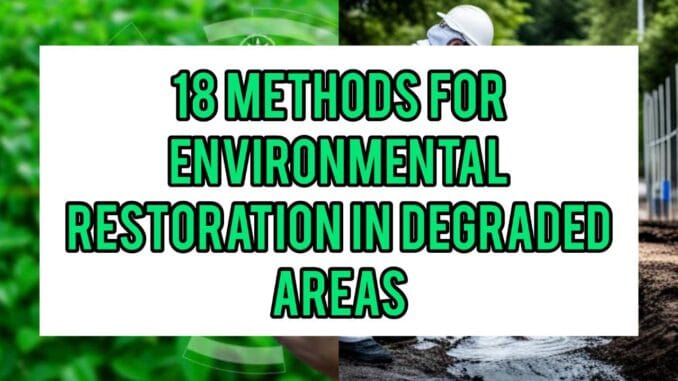
Have you ever walked through a once-thriving wetland turned dusty and barren, or passed by a hillside stripped of its trees? Those sights remind us that human activity and natural disasters can degrade the land we depend on. Environmental restoration offers hope—it’s like giving damaged ecosystems a second chance, a way to rebuild soil, water, and biodiversity so they function again. In this article, we’ll explore 18 proven methods for restoring degraded areas, uncover the challenges practitioners face, celebrate the benefits communities gain, and cover everything you need to know to get started.
Key Challenges in Environmental Restoration
Restoring nature isn’t as simple as planting a few seedlings. We wrestle with limited funding, climate uncertainty, invasive species, and community buy-in. Often, sites lack baseline data, making it hard to set realistic goals. Restoration teams must also navigate land tenure conflicts and ensure long-term maintenance. Understanding these hurdles upfront helps us plan smarter, anticipate roadblocks, and keep projects on track.
Key Benefits of Restoration
Despite challenges, successful restoration pays dividends. Healthy ecosystems purify water, store carbon, support wildlife, and protect communities from floods or landslides. They restore livelihoods—through fisheries, eco-tourism, or sustainable harvesting—and reconnect people to nature, boosting well-being. When done right, restoration transforms liability into asset, turning degraded ground into living landscapes.
Method 1: Reforestation and Afforestation
Reforestation replaces trees on deforested lands, while afforestation establishes forests where none existed. By planting native species, we rebuild canopy cover, stabilize soils, and create wildlife habitat. Young trees act like sponges, soaking up rainfall and preventing erosion. Over decades, careful reforestation can turn bare hills into thriving forests once more.
Method 2: Assisted Natural Regeneration
Rather than planting seedlings, this method protects and nurtures natural sprouts already on site. By excluding livestock grazing, controlling fire, and weeding out invasives, native plants recover on their own. It’s a low-cost strategy that leverages nature’s own resilience, suited for areas with remnant seed banks and rootstock.
Method 3: Wetland Restoration and Creation
Wetlands act as kidneys for the landscape, filtering pollutants and buffering floods. Restoration can involve re-flooding drained marshes, reshaping channels, or reintroducing native hydrophytes. In places without wetlands, constructed basins mimic natural processes—improving water quality, providing habitat, and recharging aquifers.
Method 4: Erosion Control with Terracing and Contour Bunding
On steep slopes, rain can wash vast amounts of soil downhill. Terraces—flat steps cut into hillsides—and contour bundles—raised earth embankments along contour lines—slow runoff, encourage infiltration, and trap sediment. Farmers often combine these structures with cover crops to lock soil in place.
Method 5: Riparian Buffer Establishment
Streamside zones stripped of vegetation allow sediment, nutrients, and pollutants to flow directly into waterways. Planting buffers of native trees, shrubs, and grasses along banks filters runoff, shades streams to cool water for fish, and stabilizes banks against collapse.
Method 6: Bioengineering with Live Stakes and Fascines
Bioengineering blends engineering structures with living plants. Live stakes—woody cuttings driven into banks—take root and bind soils. Fascines—bundles of brush laid in trenches—slow water and trap sediment. Over time, these living features mature into fully functional riparian habitat.
Method 7: Soil Amendments and Fertility Restoration
Degraded soils often lack organic matter and nutrients. Amendments like compost, biochar, or green manures improve structure, store moisture, and feed soil life. By rebuilding soil health, we create the foundation for plant growth and accelerate ecological recovery.
Method 8: Mycorrhizal Inoculation
Many plants depend on symbiotic fungi—mycorrhizae—to access water and nutrients. Inoculating seedlings or soils with beneficial fungal spores can boost plant survival in poor soils. This underground network also enhances soil structure and carbon storage.
Method 9: Invasive Species Removal
Non-native plants and animals can choke out native species and disrupt ecosystem balance. Manual removal, targeted herbicide application, or biological controls (like introducing specific pests) help clear invasives, giving native flora and fauna room to rebound.
Method 10: Grazing Management and Exclosures
Overgrazing by livestock or wildlife can strip vegetation and compact soils. Rotational grazing plans rest pastures periodically, allowing plants to recover. Exclosures—fenced areas—exclude grazers entirely, serving as reference strands where vegetation can regenerate undisturbed.
Method 11: Fire Management and Controlled Burns
In fire-adapted ecosystems, controlled burns reduce fuel loads, recycle nutrients, and trigger regeneration of fire-dependent species. Carefully planned under favorable conditions, these burns mimic natural fire regimes, restoring ecological balance without risking wildfires.
Method 12: Coral Reef Restoration with Transplants and Substrates
In marine settings, coral reefs suffer bleaching, storms, or pollution. Restoration techniques include transplanting healthy coral fragments onto damaged reefs and deploying artificial substrates—like concrete modules—that corals can colonize. Over time, these interventions rebuild reef complexity and biodiversity.
Method 13: Wetland Floating Islands and Vegetated Mats
For polluted urban ponds or lakes, floating islands made of biodegradable mats seeded with wetland plants absorb nutrients and filter water. These living filters also provide habitat for birds and insects, enhancing both water quality and ecological diversity.
Method 14: Urban Green Infrastructure Retrofit
In cities, restoration can take the form of green roofs, permeable pavements, and rain gardens. These features capture stormwater, reduce heat islands, and create stepping stones for urban wildlife. Retrofitting roofs and streets with vegetation reconnects fragmented green networks.
Method 15: Phytoremediation for Polluted Soils
Certain plants—like sunflowers for heavy metals or willows for organic pollutants—can extract or degrade toxins from soils. By growing and safely disposing of these plants, we gradually cleanse contaminated lands, making them safe for other uses.
Method 16: Stream Channel Restoration and Re-meandering
Straightened streams often flow faster, eroding banks and reducing habitat diversity. Restoration reintroduces natural meanders, pools, and riffles, slowing flow, diversifying habitats for fish and invertebrates, and reconnecting floodplains.
Method 17: Coastal Dune Rehabilitation
On sandy shores, dunes protect inland areas from storms and provide unique habitats. Techniques include planting dune grasses, installing sand fences, and re-establishing natural sediment pathways. These interventions rebuild dune height and stability.
Method 18: Community-Led Restoration and Citizen Science
No method succeeds without people. Engaging local communities through hands-on planting days, water monitoring, and stewardship groups embeds restoration in social fabric. Citizen science projects gather vast data on species recovery and help maintain restored sites over the long term.
Integrating Methods for Maximum Impact
While each technique has strengths, combining methods amplifies success. For instance, reforestation on hillsides pairs well with contour bunding to protect seedlings. Riparian buffers flourish alongside bioengineering structures. Urban green infrastructure can include phytoremediation features in rain gardens. A toolbox approach—selecting complementary strategies based on site conditions—yields resilient, multifunctional landscapes.
Monitoring and Adaptive Management
Restoration is a journey, not a single event. Monitoring—through photo points, vegetation surveys, water quality tests, or wildlife counts—tracks progress and flags issues. When results fall short, adaptive management tweaks methods: altering species mixes, adjusting fire regimes, or modifying grazing schedules. This feedback loop ensures restoration adapts to real-world dynamics.
Overcoming Common Challenges
Budget constraints often limit restoration scale. Partnering with NGOs, governments, and volunteers stretches resources. Uncertain land tenure can stall projects; clear agreements with landowners or communities resolve that. Climate change shifts rainfall patterns and species ranges, requiring flexible species selection and timing. By anticipating these hurdles and building collaborative networks, practitioners boost project resilience.
Long-Term Benefits for People and Planet
Restored ecosystems deliver clean water, flood protection, and climate regulation through carbon sequestration. They support fisheries, forestry, and crops, sustaining livelihoods. Green spaces enhance mental health, provide recreation, and foster stronger communities. In degraded areas turned vibrant habitats, both nature and people thrive.
Everything You Need to Start Restoration
First, assess the site: map soils, slopes, hydrology, and existing vegetation. Engage stakeholders early—landowners, local leaders, and experts—to co-design interventions. Secure funding through grants or partnerships. Develop a phased plan: pilot small plots, refine methods, then scale up. Prioritize native species and monitor rigorously. Keep communities involved with events and data sharing. With clear goals and strong alliances, restoration transforms dreams into living landscapes.
Conclusion
Environmental restoration in degraded areas is both art and science—a blend of ecological knowledge, engineering skill, and community passion. From reforestation to coral transplantation, the 18 methods we’ve explored offer tools to heal soils, waterways, and habitats. Challenges like funding, climate variability, and invasive species are real, but the rewards—clean water, carbon storage, biodiversity revival, and human well-being—are profound. By integrating techniques, monitoring outcomes, and adapting over time, we can bring lifeless places back to vibrancy. Every tree planted, seed broadcast, and community member engaged brings us closer to a healthier planet and more resilient communities.
FAQs
How long does restoration typically take to show visible results?
Timeframes vary: soil amendments can boost plant growth within months, while reforestation may take decades to form mature canopy. Wetland restoration often shows water quality improvements in 1–3 years. Patience and monitoring are key.
Which method is most cost-effective for large agricultural areas?
Assisted natural regeneration paired with rotational grazing often offers high returns at low cost, especially where seed banks remain. Adding soil amendments or contour bunds boosts success where soils are highly degraded.
Can urban areas benefit from restoration methods?
Absolutely. Green roofs, rain gardens, and vegetated buffers improve stormwater management and air quality. Phytoremediation in parks and abandoned lots can reclaim polluted soils for safe public use.
How do we choose the right native species for planting?
Consult local ecologists or nurseries for region-specific lists. Consider soil type, moisture regime, and climate projections. Mix trees, shrubs, and groundcovers to mimic natural community structure.
What role can volunteers play in restoration?
Volunteers plant seedlings, remove invasive species, install erosion controls, monitor wildlife, and host outreach events. Their efforts build social capital and help sustain projects beyond initial funding.

Paul is a seasoned ecologist with over ten years of professional experience in managing environmental resources and exploring the emerging field of space ecology. Throughout his career, he has contributed to sustainable ecosystem research and examined how ecological principles apply beyond Earth, particularly in space missions and extraterrestrial environments. His work bridges the gap between Earth-based conservation efforts and the future of human life in space, making him a valuable expert in both traditional and cutting-edge ecological studies.
Leave a Reply